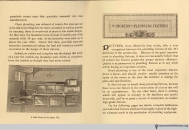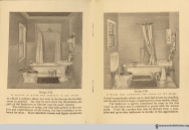By Johanna Goldberg, Information Services Librarian
It’s World Toilet Day, a day emphasizing the importance of sanitation to public health and reminding us that 2.4 billion people still do not have access to basic toilets.1 On this day, we look back to a historic time of toilet transformation in America and look forward to a time when disease-mitigating sanitation becomes available for all.
The Standard Sanitary Manufacturing Company formed in Pennsylvania in 1875.2 At that time, indoor bathrooms had only just begun to appear in urban and suburban settings, newly possible thanks to the advent of sewer systems.3 Early indoor bathrooms hid plumbing and fixtures under wooden doors and cupboards.2,4 But by the publication of Standard Sanitary’s The Evolution of the Bath Room circa 1912, open plumbing and visible commodes had taken over bathroom design: “The bathroom of today is infinitely more cleanly, durable and efficient.”2 And the public health infrastructure that allowed for them, like sewers and access to clean water, saved lives.

Back cover, The Evolution of the Bath Room, circa 1912. The 1870s-style bathroom is shown on top. The 1912-era bathroom is on the bottom.
The bathrooms of this pamphlet look like the ones we have in 21st century America (except, in some cases, for their cavernous size and luxurious fittings). But today we are not as excited about our commodes as Standard Sanitary would like us to be: “The bathroom is rightly considered by many as the first room in the home and is exhibited to guests with the utmost pride. Truly the comfort that may be derived from a complete and up-to-date bathroom is worthy of this appreciation.”2
Along with several other companies, including Kohler (founded in 1873),4 Standard Sanitary worked at the forefront of the plumbing industry. The company developed “the one-piece toilet, built-in tubs, combination faucets (which mix hot and cold water to deliver tempered water) and tarnish-proof, corrosion-proof chrome finishes for brass fittings.”5 By 1929, Standard Sanitation led the bathroom fixture market worldwide. It still exists today as the American Standard company.
Enjoy perusing the full pamphlet, full of memorable quips like: “There is nothing which will appeal so strongly to the fastidious and careful housewife, and be so great a source of enjoyment, as modern high-grade fixtures.”2
Click on an image to view the gallery.
References
1. World Toilet Day. Available at: http://www.worldtoiletday.info. Accessed November 10, 2015.
2. Standard Sanitary Mfg. Co. The evolution of the bath room. Pittsburgh: Standard Sanitary Mfg. Co; [1912].
3. Duncombe T. A long soak in the subject of bathrooms. Philadelphia Inquirer. http://articles.philly.com/1991-11-10/real_estate/25771962_1_bigger-bathrooms-toll-bros-spacious-bathrooms. Published October 1991. Accessed November 10, 2015.
4. Horan J. Sitting pretty: An uninhibited history of the toilet. London: Robson; 1998.
5. American Standard. Company Information. Available at: http://www.americanstandard-us.com/companyinfo/overview.aspx. Accessed November 4, 2015.















Pingback: The Rise of the Luxurious Suburban Master Bathroom – ARTIKEL AUS ALLER WELT
Pingback: The Rise of the Luxurious Suburban Master Bathroom – My small blog
Pingback: The War Against Coronavirus Comes to the Bathroom – Borlos
Pingback: How Infectious Disease Defined the American Bathroom – SmartCities.org
Pingback: 对抗冠状病毒的战争即将来临 – B新聞
Pingback: How Infectious Disease Defined the American Bathroom | Public Transit Blog
Pingback: Pathogens influence building architecture — the coronavirus will be no exception – Anonymous Black
Pingback: Los patógenos influyen en la arquitectura del edificio: el coronavirus no será una excepción | Mascarillas Antivirus
Pingback: How Infectious Disease Defined the American Lavatory – Aumoelleux
Pingback: Pathogens influence building architecture - the coronavirus will be no exception - Exclusive Global News
Pingback: Pathogens influence building architecture — the coronavirus will be no exception
Pingback: The Future of Home Comfort: Integrating Wellness into Bathroom Design | Water Boy Sydney Plumbing